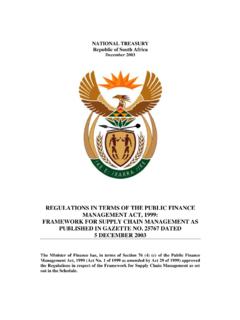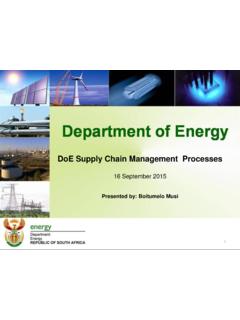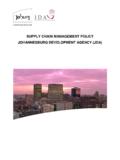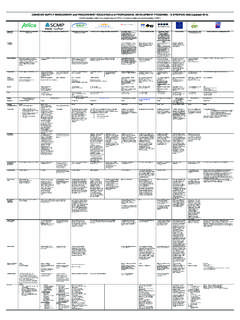Transcription of 2015 Public Sector SuPPly chain management review
1 2015 Public Sector SuPPly chain management review 1 Foreword SuPPly chain management (SCM) is one of the key mechanisms enabling government to implement policy. Traditionally, SCM has been misunderstood and undervalued. Its strategic importance has not been recognised, and it has been under-capacitated. The negative effects of inefficient Public Sector SCM, particularly in the procurement phase of the chain , are well documented. Suppliers charge excessive prices; goods and services contracted for and delivered are of poor quality and unreliable; and there is corruption and waste. The private Sector , by contrast, has tended to invest astutely in SCM in order to maximise shareholder value and ensure that its products and services match clients needs. In South Africa, government is starting to value the strategic importance of SCM to service delivery, value creation, socio-economic transformation and fiscal prudence.
2 The establishment of the Office of the Chief Procurement within the National Treasury reflects government s commitment to quality service delivery at the right place and time. This Public Sector SCM review is a candid reflection on the current state of SCM in the Public Sector ; the reforms that are being considered; and the opportunities that an efficient and effective system presents. The review reflects the views of government, business and civil society. It shows a growing appreciation that SCM reform will require collaboration and that it should be treated as a national project. If it is implemented as envisaged in section 217 of the Constitution, the benefits will be enormous: Good-quality service delivery will be increasingly possible, with significant improvements in the welfare of South Africa s citizens and especially the poor who rely heavily on government for support The economy will grow as economic infrastructure is expanded and efficiently maintained Goods, services and infrastructure will be bought at lower costs Innovation will result in different approaches to the commodities used in some sectors.
3 E-learning in primary and secondary schools, for example, could be accelerated through the purchase and use of electronic equipment. For suppliers, the cost of doing business with the state should decrease substantially. Transparency and open contracting are critical elements of any Public Sector SCM system. An important part of reforming South Africa s system must therefore be to make procurement information accessible to suppliers and purchasers alike. This will enhance planning, accountability and oversight. Lungisa Fuzile Director-General: National Treasury 2015 Public Sector SuPPly chain management review 2 31 Introduction In brief In terms of section 217 of the Constitution of the Republic of South Africa, when government contracts for goods and services it must do so in a way which is fair, equitable, transparent, competitive and cost-effective. In addition, the SuPPly chain management (SCM) system must provide for the advancement of persons or categories of persons disadvantaged by unfair discrimination.
4 These are the cornerstones of South Africa s Public Sector procurement system. In line with the Public Finance management Act (PFMA) and the Municipal Finance management Act (MFMA), the Public Sector SCM system is highly decentralised to allow managers to manage. SCM across South Africa is highly fragmented. This makes it difficult for government to obtain maximum value when buying, and making use of, goods and services. Improving skills, processes and systems is critical for a well-functioning SCM system. The Office of the Chief Procurement Officer (OCPO), working with all government institutions, will modernise and oversee the South African Public Sector SCM system to ensure that the procurement of goods, services and construction works is fair, equitable, transparent, competitive and cost effective in line with the Constitution and all relevant legislation. Overview he 2008 recession was followed by a dramatic rise in government debt, from R450 billion in 2009/10 to trillion in 2013/14.
5 This is projected to grow further over the coming years. To take account of this, while at the same time continuing with service delivery, government had to reprioritise spending and increase efficiency. Public expenditure nevertheless continues on a large and necessary scale. In 2013/14, the South African Public Sector spent R500 billion on goods and services and on construction works. These supported and enabled the delivery of services to the country s residents. This is an enormous amount of money. Wisely and efficiently spent, it can be a great force for good. It can ensure that those in need receive services, T Public spending continues to grow. It is important that these funds are spent wisely. 2015 Public Sector SuPPly chain management review 4that infrastructure such as roads and ports is built and maintained, that schools are well-equipped and that health services are widely available. It can also spread wealth to hard-working entrepreneurs who successfully tender for government contracts and, in doing so, create jobs.
6 Even those not directly involved in the Public Sector SuPPly chain can benefit, as suppliers to government source their supplies and materials from manufacturers, farmers and many others. It is well known that Public Sector SCM1 in South Africa is imperfect. There are constant allegations of corruption and inefficiency. Service delivery protests are a sign that people feel that they are not receiving the quantity or quality of services they need. Schools sometimes open at the start of the year without learner support materials. An efficient and intelligent Public Sector SCM system can help to overcome these problems. This document describes the shape and character of the present system, outlines the regulatory environment in which Public procurement takes place, makes clear the many problems that exist and points to ways in which these can be overcome. The vision is one of a South African Public Sector SCM system staffed by people who have the skills, knowledge and enthusiasm to ensure that every decision is well-informed and appropriate; and who have the technical and organisational support that they need in order to carry out this important work in line with the country s Constitution, laws and regulations.
7 The current Public Sector SCM situation A number of issues prevent Public Sector SCM from performing as well as it should. The strategic importance of SCM is not well understood. Those working in the system need to understand the economic and social power of the purchasing decisions that they make. These should not only be of maximum value to the intended beneficiaries whether these are hospital patients who receive the medication they need or commuters with access to good Public transport but also give expression to government s policies and strategies and support business development. Translating budgets and strategic plans into deliverables requires an efficient Public SCM system which is well-resourced, functions efficiently and whose central importance is recognised. The organisational structures and systems within which SCM takes place are in too many cases not ideal, with inexperienced or under-skilled leadership, high staff turnover and lack of motivation.
8 There may also be a lack of suitable equipment, such as computers with dependable internet connections; or information, such as databases giving up-to-date details of available products and services. 1 Although section 217 of the Constitution refers to procurement and the terms are used inter-changeably; for the purpose of clarity and common understanding in this review , procurement is used to describe the process of implementing a decision to buy, flowing from the pre-tendering process of SuPPly chain management . Whereas SuPPly chain management (SCM) refers to the all processes leading up to procurement and post procurement. South Africa s Public Sector SCM system has many imperfections An efficient Public Sector SCM system is attainable The strategic importance of Public Sector SCM is not well understood CHAPTER 1: INTRODUCTION 5 The lack of clarity about the roles and responsibilities of technical staff and of political officer bearers creates scope for interference, and this gives rise to allegations or instances of corruption.
9 SCM practitioners frequently do not have the skills, knowledge and experience that they need. While the system contains many excellent people, competency assessments show significant gaps in SCM skill and knowledge. This document gives information about some of the serious and rapid steps being taken to address this problem. There are few if any consequences for those who, despite support and encouragement, fail to perform at the required level. Repeated negative reports by the Auditor-General (AG) highlight this lack of accountability. An improved and more dynamic Public SCM system should bring out the best in its officials, and there must be consequences for those who are not willing to play their part for the Public good. Policies and regulations are often confusing and cumbersome. Suppliers have to fill out numerous forms, often many times.
10 This costs time and money and is a particular problem for small businesses with little or no administrative capacity or support. It is government policy to support the growth of small businesses and the jobs they create. Procedures that stand in the way of this, and which are also difficult for officials to interpret and implement, must and will be changed. The Public Sector frequently underestimates how important supplier management is, and there is limited understanding about how Public Sector decisions and actions affect the overall business environment. On the other hand, suppliers often take advantage of the current weak Public Sector SCM environment. This is evident in high prices paid for goods and services; contracts that favour certain suppliers; collusion; unethical behaviour; non-performance; and poor quality products and services rendered. To overcome these problems, the Public Sector needs to develop long-term strategic supplier relationships.


















